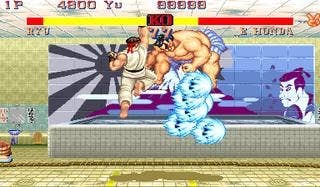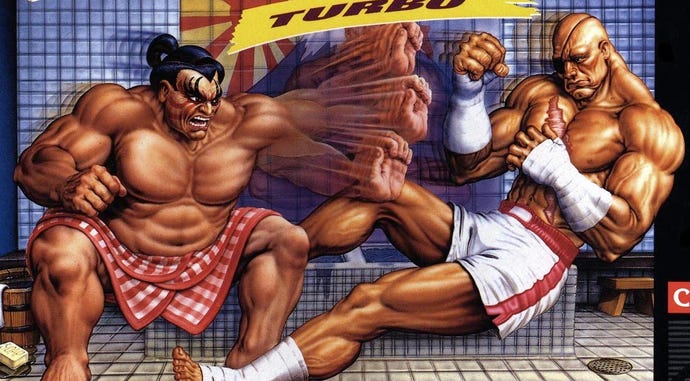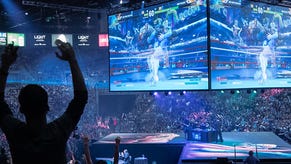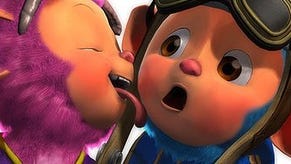How Hackers Reinvented Street Fighter 2
Eurogamer's Joel Snape looks at how a bunch of '90s bootleggers influenced the development of Capcom's classic fighter.
This article first appeared on USgamer, a partner publication of VG247. Some content, such as this article, has been migrated to VG247 for posterity after USgamer's closure - but it has not been edited or further vetted by the VG247 team.
'Round one. Fight!' booms the announcer, just like he has a million times before.
Guile opens with a Sonic Boom, Ryu counters with a fireball. So far, so familiar. Then the first strange thing happens: Guile throws another Sonic Boom, much faster than his two-second charge time should allow. Ryu's forced to block one, then another. He jumps backwards to get space, and the second oddity occurs - he unleashes a fireball mid-leap, 'standing' on thin air. As soon as it leaves his hands, it veers towards Guile, who's already into the animation for his next shot. Meanwhile, two Sonic Booms are already humming through the air, glacially slow but ominously relentless. Ryu retaliates again, then again. Soon, the screen is a stream of projectiles, Guile's signature yell overlapping itself: 'Sonic-sonic-sonic-sonic...'
If you walked into an arcade in the early '90s, this sort of thing wasn't an unusual sight. After the release of Street Fighter 2 in '91, Champion Edition a year later, and a slew of similar games -- Fatal Fury, Art Of Fighting and World Heroes the standouts -- in between, the pace of releases still wasn't enough to satisfy hardcore fight fans. Players and arcade owners turned to the slew of bootlegged versions being released, and one in particular: the Rainbow Edition, known by its multi-coloured version of the title screen and released -- according to text hidden in the ROM -- by a group known as Hung Hsi Enterprise Taiwan. Made by replacing chips on the standard Champion Edition board with reprogrammed variants, it horribly broke the game's balancing -- but also improved it in unexpected ways.
"I saw an old Rainbow Edition in my laundromat a while ago, it's weird how it spread around," says Patrick Miller, columnist at shoryuken.com. "Fireballs coming out of the Dragon Punch was always the craziest thing to me, but there was some interesting stuff with Guile's fast-and-slow Sonic Booms."

Other changes include charge time being ignored, most special moves being available mid-jump, and multiple projectiles being possible. Slow hadokens home in on the other character, fierce ones come out almost too fast to see, and moves like the Hurricane Kick and Dragon Punches cover the entire screen. Zangief, already regarded as top-tier by elite players, becomes borderline unstoppable, able to screen-leap upwards until he's invincible to attacks, but still able to pull off his spinning piledriver.
"I played Rainbow Edition in the arcades a fair amount," says David Sirlin, lead designer on Super Street Fighter 2 Puzzle Fighter Remix and author of Playing To Win. "It's crazy and not serious, but pretty fun. You had walls of fireballs with Sagat, Dhalsim with insanely fast walk speed, rather than the slowest in the game, Blanka throwing fireballs...fun."
Then there are genuinely bizarre changes: land Blanka's neck-bite, for instance and the Brazilian monster morphs into Ryu doing a slow-motion Dragon Punch. Players can change into other characters, mid-match, narrowly beating Mortal Kombat 2's playable Shang Tsung to the punch.
Not every version is the same: one little-seen variation replaced Balrog with Fatal Fury protagonist Andy Bogard. There were Rainbow Editions of World Warrior, and later, SSF2, but none were as enduring as the Champion Edition. You can still find playable MAME versions of Rainbow online, alongside versions called Black Belt and Lightning, if you're prepared to invest the time and skirt the law. Recently, a Japanese tournament brought dedicated players together to compete on Rainbow Edition, the most broken Street Fighter ever.
But this is where the story gets interesting. Because, while players were fine-tuning their attack patterns with overspeed Dhalsim, Capcom was working on Super Street Fighter 2, the first update of Street Fighter 2 that would add all-new characters and moves. Cammy, T.Hawk and the gang would hit arcades in 1993, but before then -- at the end of '92 -- Turbo Hyper Fighting was released. And although a fantastic and much better-balanced game, it's far from a 'true' update -- every new move, from Dhalsim's teleport to Chun Li's fireball, cuts and pastes artwork and sound effects from Champion Edition.
Some rumors have it that Capcom brought out Turbo Hyper to keep public interest in Street Fighter 2 while the New Challengers was being developed. Others have it that Capcom was considering a lawsuit against Hung Hsi, and thought that the update might strengthen their case. But Turbo Hyper -- and later games, like the Marvel Vs Capcom series -- do have similarities with the Rainbow Edition. Aerial Hurricane Kicks, obviously. Fireballs for some characters, moves that go through fireballs -- like Honda's splash -- for others. Other improvements, like Blanka's vertical roll, which were actually in the Rainbow Edition. And, of course, the pace is ramped up enormously. Was Turbo actually influenced by the Rainbow Edition? Capcom has never officially confirmed or denied, but the similarities are obvious.
"When Rainbow Edition was in arcades, and people liked it, Capcom wanted to release a new game sooner than later," says Sirlin. "So in the meantime, they released an update that used the existing CPS1 hardware with no new sprites, just existing sprites recycled. It's interesting that that market pressure made them release a game quickly (Hyper) that was arguably better than the game they actually cared about (Super)."
In the end, interest in Rainbow Edit waned. Hung Hsi, under pressure from multiple lawsuits, disbanded. With Super Street Fighter 2 Capcom moved their arcade boards to new CPS2 hardware, using encryption architecture so impressive that it wouldn't be cracked until the early 2000s. Akuma appeared and distracted everyone. But there are still echoes of the Rainbow Edition whenever you watch a modern fighting game -- whenever you see Chun Li do a double-jump or watch a character fire homing projectiles.
"I'd suggest that the logical extension of Rainbow Edition is Marvel vs. Capcom 3," says Miller. 'It gives you the tools to put teams together that don't allow the other player to play properly. When you lose to them, you feel like the game is unfair, that certain stuff shouldn't be in the game." But then, this is part of Marvel vs. Capcom's charm -- unleashing an utterly unstoppable combination that overwhelms the opposition.
"Guilty Gear's 'gold' characters are the same kind of idea," says Sirlin. "Overpowered insane broken stuff." Meanwhile, echoes of Hung Hsi live on in the thriving PC modding community, where updates to Street Fighter 4 give players overpowered Ultra attacks, teleport dashes, more aerial moves -- and, in the case of the well-loved Koryu edition, change huge chunks of the gameplay to be similar to SNK's King Of Fighters series.
The Rainbow Edition lives on in spirit: it'll always have a place in the ridiculous, over the top evolution of fighting games. And there's always a chance that if you go to the right out-of-the-way arcade, be it in Akihabara or Blackpool, you'll see a screen full of Sonic Booms and Blanka throwing fireballs. Those were the days.

















